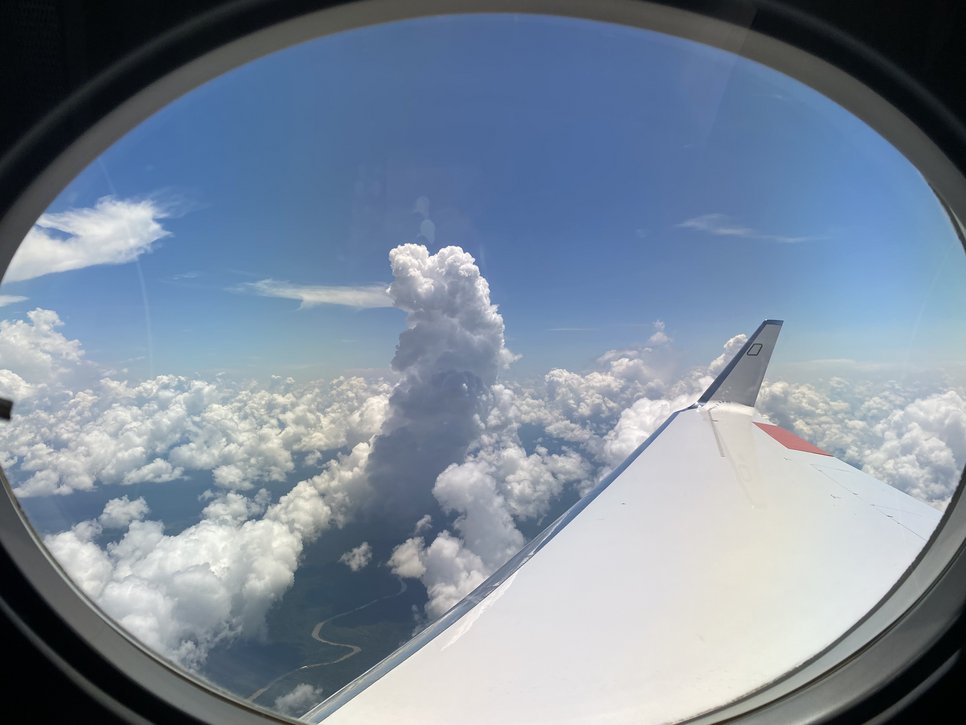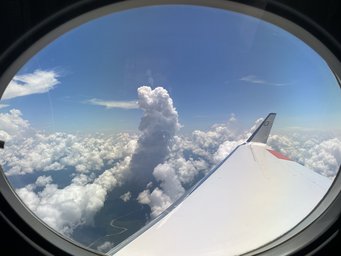How the Amazon rainforest reaches for the clouds
New study highlights Amazon’s critical role in the Earth’s climate system, revealing that land-use changes and accelerating deforestation reduce biogenic trace gas emissions and impact atmospheric chemistry up to 12 km altitude.
The Amazon rainforest is the largest source of biogenic volatile organic compounds (BVOCs) to the atmosphere worldwide. To understand the distribution and chemistry of BVOCs, airborne and ground-based measurements of BVOCs were conducted over the Amazon rainforest in the CAFE-Brazil campaign (short for: Chemistry of the Atmosphere: Field Experiment in Brazil) during December 2022 till January 2023.
Based on the CAFE-Brazil datasets, a new study from the Max Planck Institute for Chemistry shows that deep thunderstorm convection over the Amazon rainforest transports BVOCs up to ten to twelve kilometers above the canopy, where they accumulate during the night, before igniting dawn photochemistry in the upper atmosphere. The study is published in the journal Nature Communications.
To the point:

- Distribution of trace gases: Tropical deep convection in the everyday thunderstorms has a strong impact on the altitude distribution of short-lived trace gases like isoprene and monoterpenes, with little influence in the mid-troposphere (three to nine km) but elevated levels in the upper troposphere (9-14 km).
- Accumulation over night: Nocturnal convection effectively transports biogenic species from the forest to the upper troposphere, where they accumulate through the night without effective oxidation, and then rapidly oxidize at daybreak.
- Model results: Reducing biogenic emissions, for example through deforestation, leads to higher OH radical concentrations in the atmosphere and therefore a shorter lifetime of most biogenic gases, and more ozone near the forest, although less ozone at 12km.
Land-use changes and deforestation impact atmospheric chemistry
First author Nidhi Tripathi explains: "Plants may be rooted to the ground, but they have a surprising atmospheric reach. Through deep convection, they send chemicals — biogenic volatile organic compounds — aloft into the upper troposphere where they steer atmospheric chemistry on a regional scale.” Deep convection occurs both during the day and at night. This study uncovers the important role of nighttime convection in transporting BVOCs, which can significantly contribute to new particle formation in the upper troposphere after sunrise, emphasizes the Postdoctoral researcher at the MPI for Chemistry. „Our study also highlights Amazon’s critical role in the Earth’s climate system, revealing that land-use changes and accelerating deforestation could dramatically alter BVOC emissions, with significant consequences for both regional and global atmospheric chemistry.”

“It is remarkable that the reactive compounds emitted from the rainforest can reach the cold, dry upper atmosphere, and exert such a powerful effect on the chemistry there”, says Jonathan Williams, group leader at the Atmospheric Chemistry department at the MPI for Chemistry. “By operating our aircraft and our ground-based station ATTO in parallel, by day and by night, we could track how the Amazonian BVOC varies at different altitudes. Near the forest canopy BVOC concentrations peak around midday along with light and temperature. But at twelve kilometers the peak concentrations were observed around 5 a.m. in the morning after building up through the night. This means the upper atmosphere is primed for photochemistry as dawn breaks”.
How deforestation affects the Amazonian atmosphere
Deforestation is an important issue in the Amazon basin, Williams states: “We were keen to understand how the atmosphere would react to associated changes in BVOC emissions. By first measuring over pristine and cleared areas, and then modelling different BVOC emission scenarios, we were able to show how sensitive the Amazonian atmosphere is to potential future deforestation.” The new study reveals that deforestation of the Amazon rainforest results in reduced BVOC emissions. This reduction can lead to higher ozone levels near the surface, because under pristine conditions, BVOCs help remove ozone from the air. Surface-level ozone can be harmful to both humans and the environment.
Forest ecosystems regulate atmospheric chemistry through VOC emissions
The main primary BVOC emissions are isoprene (C5H8) and monoterpenes (C10H16). Once released, BVOCs are oxidized rapidly by OH radicals, ozone (O3), and, to a lesser extent, NO3 radicals, into multiple secondary volatile oxidized products and aerosol particles. Nidhi Tripathi explains that BVOC emissions can influence the atmospheric oxidation capacity, particulates, and the radiative budget. A fraction of the particles formed can become cloud droplets, further influencing the energy budget and hydrological cycle.
BVOCs are what make the familiar forest scent we know from countryside walks. “The multitudinous BVOC molecules can modulate oxidative stress in leaves, allow communication between plants and insects within the forest, but now we know that they can also impact atmospheric chemistry over large areas by influencing both ozone and particle production, right up to 12km altitude”, says Jonathan Williams.
What comes next?
In future studies the scientists from Mainz plan to focus more on the dawn chemistry. To understand the chemistry in this cold, dry, low-pressure environment of the upper troposphere they will need laboratory studies, modelling and further measurements. Previously, BVOC chemistry has been mainly studied under surface conditions.
Additional information:
First author Nidhi Tripathi was supported by the Humboldt foundation and Max-Planck-Institute for Chemistry.
Investigations on chemical processes over the Brazilian rainforest: CAFE-Brazil
During December 2022 and January 2023 an international research team under the leadership of the Max Planck Institute for Chemistry spent around 60 days collecting data on the chemical processes in the largely pristine atmosphere above the Amazon rainforest in Brazil. The primary objective of the CAFE-Brazil campaign was to gain new insights into the chemical processes in the atmosphere above the tropical rainforest and also into the interactions between the biosphere and the atmosphere. To better explain the fundamental role of the rainforest in the terrestrial system, the international scientists used the research aircraft HALO (High Altitude and Long Range Research Aircraft), which is operated by the German Aerospace Center (DLR).
The scientific objectives of the CAFE-Brazil campaign
The researchers involved in the CAFE-Brazil campaign aimed to use the aircraft measurements to investigate how atmospheric oxidation processes take place in the troposphere above the Amazon rainforest and how they influence the formation and growth of aerosol particles, which are of central importance as cloud condensation nuclei.
The scientists also wanted to answer the question of why the atmosphere's self-cleansing nature does not suffer over the rainforest, even though huge amounts of hydroxyl (OH) radicals are constantly being consumed. The chemical compound OH is considered a detergent for the atmosphere because it oxidizes pollutants such as methane and produces water-soluble reaction products that are washed out of the air with the rain.
For the CAFE-Brazil mission, HALO was equipped with 19 instruments that measure dozens of parameters, including aerosols, anthropogenic and biogenic volatile organic compounds, sulfur and nitrogen oxides, carbon monoxide, methane, ozone, free radicals, and water.
Besides the MPI for Chemistry, the large-scale mission CAFE-Brazil also included researchers from the Goethe University Frankfurt, the Universidade de São Paulo, and the Instituto Nacional de Pesquisas Espaciais. Read more on the CAFE-Brazil campaign here: https://www.mpic.de/5299698/cafe-brazil-kampagne
Data from the Amazon Tall Tower Observatory (ATTO)
In addition to the airborne data, the new study by Tripathi et al. used measurements from the Amazon Tall Tower Observatory ground site, situated in the pristine rainforest 150 km northeast of Manaus, which allowed 24-hour data coverage at 320 meters over the two-month CAFE-Brazil campaign. The combination of airborne and ground-based datasets provided new insights on the vertical (0.3 – 14 km), temporal (24-hour profiles at multiple altitudes) and the spatial distribution of BVOCs over the Amazon rainforest.
ATTO is a German-Brazilian joint project which was launched in 2009. It is managed by the Max Planck Institutes for Biogeochemistry in Jena and for Chemistry in Mainz, as well as by the Brazilian INPA and the Amazon State University (UEA) in Manaus. The project is funded by the German Federal Ministry of Education and Research (BMBF), the Ministério da Ciência, Tecnologia e Inovações (MCTI), the Max Planck Society and the Brazilian organizations including FAPEAM and individual researchers bring funding from other scientific funding agencies.
The tower aims to deliver groundbreaking findings which will be the basis for improved climate models. With a height of 325 meters, the tower extends the ground-level boundary layer, and provides information from approximately 100 square kilometers of the world´s largest forest area.
More on ATTO: https://www.mpic.de/3538403/ATTO

